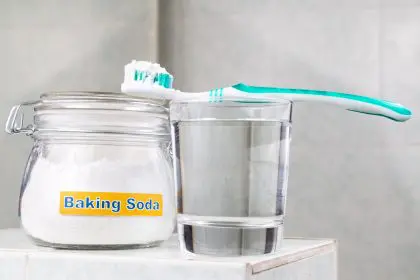Ever looked in the mirror midday to find flaky patches appearing through your foundation? Those stubborn dry spots that seem to emerge from nowhere, making your carefully applied makeup look patchy and uneven? Before you blame your moisturizer or the weather, consider that the culprit might be hiding in your daily makeup routine.
A surprisingly common habit is silently sabotaging your skin’s moisture barrier, and most of us are doing it without even realizing the damage we’re causing. The good news? Once you identify this sneaky skin-drying behavior, it’s remarkably easy to fix.
The layering mistake that locks in dryness
The makeup habit causing those frustrating dry patches isn’t about the products themselves — it’s about their application order and timing. Specifically, it’s applying powder products directly over areas that haven’t been properly prepped or that are already showing signs of dryness.
When you dust setting powder, powder foundation, or powder blush over skin that’s already lacking moisture, you’re essentially sealing in the dryness. Powder products are designed to absorb excess moisture and oils. When applied to already-dry areas, they pull out what little hydration remains while creating a barrier that makes it difficult for your natural oils to rehydrate the area throughout the day.
This seems obvious once pointed out, but the majority of makeup wearers unconsciously follow this exact pattern. They notice a slightly dry-looking spot, and their instinct is to quickly powder over it to “fix” the appearance. This temporary visual solution actually compounds the underlying problem, creating a cycle of increasingly parched skin.
What makes this habit particularly problematic is that it trains us to use more powder each time, as the dry patches become more noticeable. Eventually, this leads to chronically dehydrated patches that seem resistant to even your richest moisturizers.
The microscopic makeup trap
To understand why this habit is so damaging, we need to look at what’s happening on a microscopic level. Your skin’s surface has tiny crevices and overlapping cells. When your skin is well-hydrated, these cells lie flat and create a smooth canvas. When dehydrated, they begin to lift and separate.
Powder makeup particles are designed to nestle into these microscopic spaces. On hydrated skin, they create an even, diffused appearance. But on dry skin, they wedge between lifted skin cells, exaggerating the flaky texture while preventing moisturizing agents from reaching the deeper layers where they’re needed most.
The situation worsens when we consider the ingredients in most powder products. Many contain absorbent materials like silica, talc, or kaolin clay — all excellent at soaking up oils but potentially disastrous for already-dry areas. These ingredients don’t distinguish between “good” hydrating oils and excess shine. They absorb everything, leaving vulnerable patches even more dehydrated.
This creates what dermatologists call a “moisture trap” — a condition where products are preventing natural hydration from reaching the skin’s surface while simultaneously drawing out what little moisture remains.
The makeup artist secret to flake-free finish
Professional makeup artists rarely encounter this problem, not because they use drastically different products, but because they follow a specific application sequence that prevents dry patch formation.
The pro technique starts with targeted spot hydration. Instead of applying the same moisturizer all over and immediately moving to makeup, they assess the skin’s condition and give extra attention to potentially dry areas. Any spots showing even slight dryness receive an additional layer of hydration, whether through a richer moisturizer, a hydrating serum, or a moisturizing primer.
Crucially, they then allow this additional hydration to fully absorb before applying any powder products. This patience — often just an extra minute or two — ensures that the moisturizing ingredients actually penetrate the skin rather than sitting on the surface where they’ll be immediately absorbed by powder particles.
When powder products are necessary, they apply them with a light hand only in areas that truly need oil control, usually the T-zone, while avoiding potentially dry areas like the cheeks, jawline, and around the eyes and mouth. This targeted powdering preserves the skin’s natural moisture in vulnerable areas while still controlling shine where needed.
Breaking the dry skin cycle
The first step to breaking this damaging habit is recognizing the dry-prone areas of your face. For most people, these include the cheeks, especially near the nose, the area between the eyebrows, the corners of the mouth, and sometimes the forehead near the hairline.
Once identified, these areas need special treatment both before and during makeup application. Start by giving these spots an extra layer of hydration in your skincare routine. This could be as simple as applying a second layer of your regular moisturizer just on these areas, or using a more intensive hydrating product specifically on dry-prone spots.
The crucial change comes in your makeup routine. Create a mental “no-powder zone” over these vulnerable areas. If you use powder foundation, consider switching to a liquid or cream formula, at least for the drier portions of your face. If you love your powder products, try applying a hydrating setting spray before and after powder application to provide a moisture buffer.
For emergency touch-ups during the day when dry patches appear, resist the urge to add more powder. Instead, keep a small facial mist in your bag. A quick spritz followed by gentle patting with your fingertips can rehydrate the area without disturbing your makeup. Only after reintroducing moisture should you consider the lightest possible dusting of powder if absolutely necessary.
The ingredient saviors for powder lovers
If you’re devoted to your powder products but struggle with dry patches, look for formulations containing ingredients that mitigate moisture loss. Modern powder formulations have evolved significantly, with many now incorporating hydrating elements specifically designed to prevent the drying effect of traditional powders.
Powders containing hyaluronic acid, glycerin, or squalane provide the oil-absorbing benefits you want while simultaneously helping to maintain hydration levels. These ingredients act as humectants, attracting moisture from the air to your skin even through the powder layer.
Another ingredient category to seek out is ceramides. These lipid molecules help repair and reinforce your skin’s moisture barrier, making it more resilient against the drying effects of powder products. Powders infused with ceramides not only avoid exacerbating dryness but can actually improve your skin’s hydration capacity over time.
For those who find their skin becomes progressively drier throughout the day despite using hydrating powder formulas, consider the environmental factors at play. Office heating and air conditioning can dramatically reduce ambient humidity, pulling moisture from your skin continuously. In these environments, keeping a hydrating face mist at your desk for midday refreshing can preserve your makeup’s appearance while preventing the formation of dry patches.
The seasonal adjustment that prevents flaking
One often-overlooked aspect of the powder-dry skin relationship is the need to adjust your routine seasonally. The powder application that works perfectly in humid summer months can become your skin’s worst enemy during dry winter conditions.
As seasons change, so should your powder habits. In colder, drier months, consider using powder products only where absolutely necessary, like the center of your forehead and around your nose. Leave the perimeter of your face powder-free to maintain natural moisture levels.
The transition between seasons is when dry patches most commonly emerge, as your skin hasn’t yet adapted to changing humidity levels. During these periods, be particularly vigilant about spot-treating emerging dry areas and resist the urge to cover them with more product.
Your aging skin requires evolved powder techniques as well. What worked in your twenties can create exaggerated texture in your thirties and beyond, as skin naturally becomes drier with age. The amount and placement of powder should be reassessed every few years, generally moving toward lighter application as you age.
This simple awareness — that our powder habits might be the hidden cause of those frustrating dry patches — can transform your makeup experience. By breaking the cycle of powdering over dryness, you’re not just improving your makeup’s appearance today. You’re actually allowing your skin’s moisture barrier to repair itself, leading to naturally more hydrated skin that requires less correction over time.












